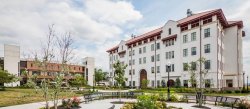Math History Maker Faire
The Spring 2019 History of Mathematics (MATH490) class experimented with a new approach to assessment culminating in the presentation of its project-based findings on May 13.
Posted in: Mathematics

Professor Eileen Fernández, the instructor, has been involved in a separate project which considers how learning can be enhanced through the process of Making or of designing and innovating with tools and materials to create products that are usable to students outside their classroom boundaries.
A Making approach to learning is based in a theory called constructionism. This theory combines the principles of constructivism with those of Making to encourage teachers to actively incorporate students’ thinking into their learning and into constructing something that can be usable to them beyond the classroom. In all her classes, Professor Fernández attempts to invoke constructivist principles by encouraging students’ thinking and using this thinking in classroom problem-solving. By integrating students’ insights into mathematical justifications, proofs, and even assessments, she aims to give students (versus textbooks or the professor) agency over their own learning.
The event left no doubt that the possibilities for learning mathematics can extend beyond classroom boundaries.
The majority of students in the history of mathematics class are prospective 6-12, mathematics teachers, although the occasional math major also enrolls. Given this background, Professor Fernández introduced a project-based assessment in which the prospective teachers were charged with Making products that could be usable to them as teachers of mathematics. For example, a lesson attempting to humanize mathematics through the study of George Pick and his elegant theorem about areas of special polygons led to the creation of posters of favorite mathematicians that the teachers could use to decorate their classrooms and inspire students. In another example from a lesson on the history of order of operations, the prospective teachers studied how mathematicians navigated many of the same issues students navigate today with this topic. This led to the creation of Order of Operations Jeopardy games! For this project, the prospective teachers developed categories and researched accompanying history anecdotes to write order of operations problems they could use when teaching this topic to their students in the form of a game.
The Maker movement in education celebrates its products through fairs, so as a culminating experience for her class, Professor Fernández and her prospective teachers displayed their learning and products in the first-ever, Math History Maker Faire! The prospective teachers developed interactive displays highlighting products made, mathematics problems studied, and related history for discussions. This provided an environment for CSAM students and faculty to engage with the same learning as the class.
The event even attended by parents and children of multiple home schools in the NJ area! This gave the prospective teachers an invaluable opportunity to make their work accessible to learners of all ages, to share their work with the University community, and put their work into practice with individuals from the home-schooling population!
Click on an image below to enlarge photo.
- Welcome Station with Aliena, Meagan and Tara
- Order of Operations Station 1 with Kylie, Victoria and Michelle
- Order of Operations Station 2 with Tina and Jessica
- Pick’s Theorem Station with Ashley, Monica and Sandy
- Complex Variables Station with Sondos, Osvaldo, and Nurys
- Fibonacci Station with Megan, Ala, Ayah, and Ahmad
- Tara helps students with Bhaskara’s proof of the Pythagorean Theorem at our Welcome Station.
- Jenna, Nikki and Lauren engage passerby at the Egyptian Algorithm Station
- Jenna, Nikki and Lauren engage passerby at the Egyptian Algorithm Station
- Tina helping with an Order of Operations problem
- Professor Greenstein helping with parenthesis in an expression
- Tina helping with an Order of Operations problem
- Ahmad, Ala, Megan and Ayah ask students which rectangle is their favorite
- Ayah and Megan help a student with Fibonacci’s sequence Hershey kisses
- Nurys looks on as Professor Bal solves for nth roots of unity!
- Finding lattice polygon areas
















